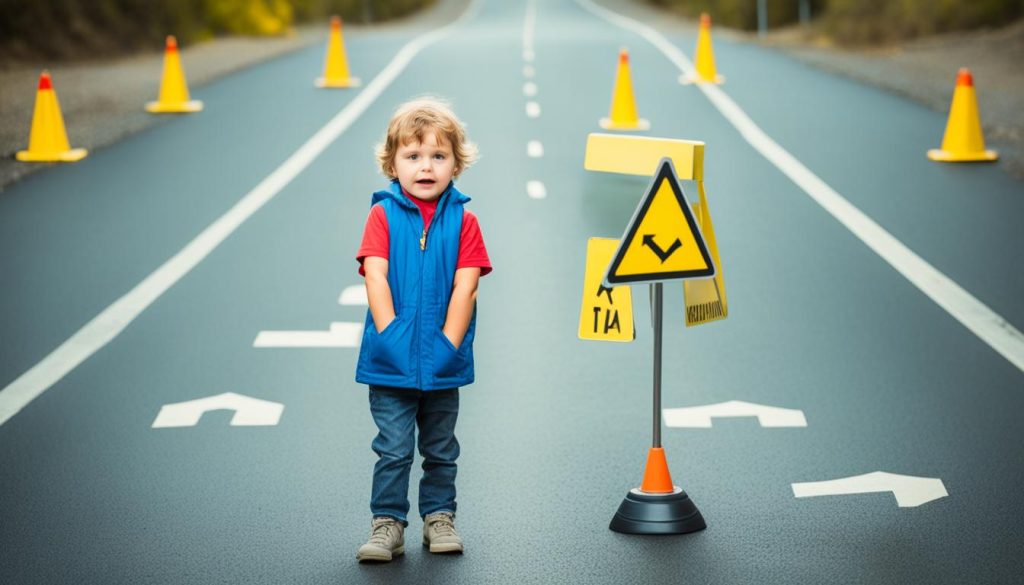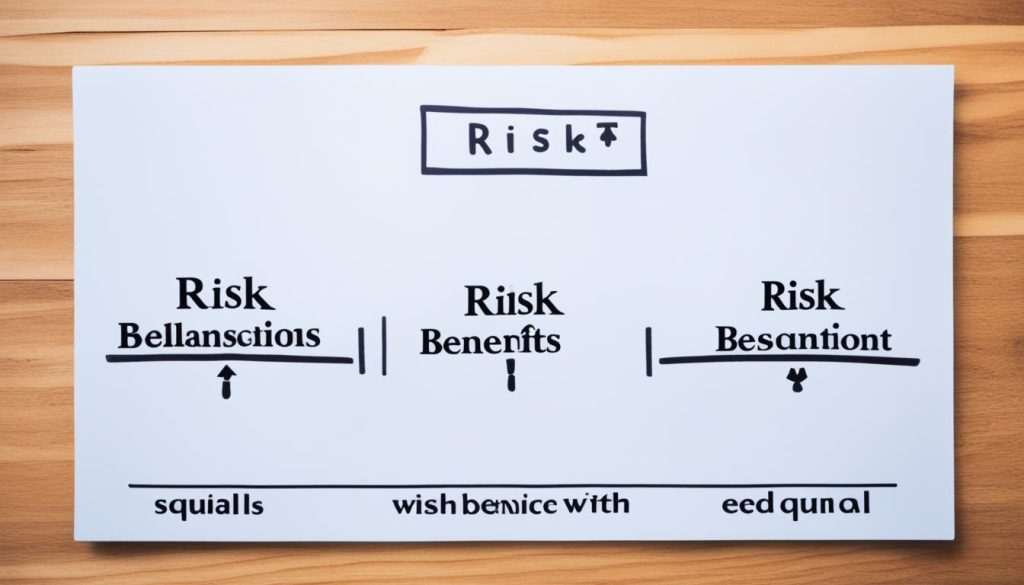Walking your child to kindergarten on their first day, you feel a mix of pride and worry. Their small hand in yours, you wonder if you’ve prepared them enough for this big step. These moments of stepping out of their comfort zone help build resilience and confidence.
The essence of positive parenting is finding a balance. It’s about letting them explore and learn from their mistakes. Remember the first time you let your child climb the monkey bars? It was a moment of heart-stopping excitement, showing their growth and self-discovery.
Studies show that kids who take healthy risks become more confident and competent. Trying out for a school play or making new friends teaches them important child development milestones. It’s important to use specific reasons for saying no, not just vague rules. Some kids love skateboarding, while others find courage in answering questions in class.
Letting your child take risks with your guidance teaches them to be responsible and resilient. Your actions say, “I trust you.” These early lessons in effective discipline strategies and risk-taking help their mental health and prepare them for the future.
Key Takeaways
- Encouraging healthy risk-taking is crucial in child development milestones.
- Balance independence and safety to foster positive parenting.
- Differentiating between risks and hazards helps in teaching kids responsibility.
- Supporting child mental health involves allowing safe failures.
- Role modeling and sharing your experiences build trust and confidence.
The Importance of Risk-Taking in Child Development
Understanding the role of risk-taking in child development is key for parents and caregivers. Encouraging your child to step out of their comfort zone boosts their confidence and success. It’s important to find a balance between keeping them safe and giving them freedom to grow.
Many parents choose fear over facts when deciding on activities for their kids. This can stop kids from growing. Teaching kids to be creative and grateful helps them learn from risks. By facing well-chosen risks, they learn to tell good outcomes from bad ones.

Each child grows at their own pace, and what’s right for one might not be for another. Slowly introducing them to tough activities helps them become independent and learn important life skills. Teaching kids to have a growth mindset is crucial. By high school, they should be able to shop and move safely on their own.
It’s important to find a middle ground between being too protective and being too careless. Parents want to keep their kids safe, but it’s also key to let them explore, make mistakes, and learn in a safe space. This balance helps kids develop good habits, use their opportunities, express themselves, and gain confidence.
Crime rates have gone down in big cities in North America over the past forty years. Even with more people living apart, it’s crucial to slowly introduce kids to challenges. This way, they learn to take risks wisely, improving their problem-solving, tolerance for frustration, and decision-making.
Distinguishing Between Risks and Hazards
It’s key to know the difference between risks and hazards when setting boundaries with kids. Risks are things kids might choose to do, like trying new things. Hazards are dangers that can hurt them, like an open swimming pool. Knowing the difference helps us keep kids safe.
Understanding the Difference
Risks are things kids might do on purpose, like climbing high or trying a new sport. These can help them grow by teaching them and building their confidence. But, hazards are dangers that can hurt them without warning, like a broken toy or a slippery floor.
Managing screen time is also about knowing the risks and hazards. Too much screen time can be a hazard, so we set limits to keep kids safe.

Examples to Clarify
Let’s look at some examples to show the difference:
| Risks | Hazards | Outcome |
|---|---|---|
| Playing on a well-maintained playground | Broken equipment on a playground | Risk: Promotes physical skills vs Hazard: Potential injury |
| Tried climbing easy rock walls with supervised guidance | Unmonitored climbing, slippery surface | Risk: Builds confidence vs Hazard: Severe fall |
| Attempting a new challenging puzzle | Puzzle pieces with sharp edges | Risk: Enhances problem-solving skills vs Hazard: Physical harm |
Parents should teach kids the difference to keep them safe and help them grow. Good parent-child communication is key. It helps kids understand why we set rules and keeps them safe.
Benefits of Healthy Risk-Taking
Encouraging your child to take healthy risks is key to their growth. When they face challenges in a safe space, they feel positive stress. This stress motivates and prepares them for the future. Let’s look at the main benefits of healthy risk-taking.

Building Confidence
Healthy risk-taking is a big part of Positive Reinforcement Parenting. When kids step out of their comfort zones, like ordering at a restaurant or trying out for a team, they gain confidence. These experiences teach them how to tackle future challenges, boosting their self-esteem. Research shows that girls who take risks have higher self-esteem than those who don’t.
Promoting Independence
Taking risks helps kids become more independent. By letting them take risks, parents teach them to handle life’s uncertainties. Kids who try risky play and face minor injuries learn their limits. This is key for both young and teenage kids, helping them learn resilience.
Developing Problem-Solving Skills
Encouraging kids to take risks helps with social skills and problem-solving. Whether it’s climbing a tree or trying new social situations, they learn to think and make decisions. These skills are vital for kindergarten and beyond, making them capable of handling success and failure.
| Age Group | Positive Risk Activities |
|---|---|
| Toddlers | Climbing playground structures, trying new foods |
| Preschoolers | Ordering for themselves at a restaurant, engaging in group play |
| School-aged children | Playing new sports, joining clubs, tackling harder puzzles |
| Teenagers | Talking to new people, taking on leadership roles, applying for jobs |
By pushing for activities that encourage independence and problem-solving, you’re building a resilient child. Letting kids experience and learn from failure shows them it’s a chance to grow. This teaches them that effort matters as much as results.
How to Assess Risk vs. Benefits
When thinking about letting your child try something risky, it’s key to look at both the dangers and the good parts. This way, you make sure you’re keeping them safe and helping them grow. Start by asking important questions and think about what your child needs and can do.
Questions to Ask
Ask yourself, “What’s the worst that could happen?” and “What’s the best possible outcome?” These questions help you see the possible bad and good sides. Also, think about if the activity will help your child build resilience or fit their way of learning. Make sure the risks are worth it for their growth.

Relating it to Your Child
Every child is different, and they’re ready for things at their own pace. Look at their skills and if they can follow directions. For example, letting them walk to school alone or play safely on the playground can help them build resilience. Playing in a safe way helps them learn and make better choices.
Think about how your child acts with their siblings and deals with sibling rivalry. Encouraging them to take safe risks can help everyone get along better. It’s a great way to teach them to work together and understand each other.
The role of play in child development is huge. Play lets kids try new things, learn, and grow. By thinking about the risks and benefits, you can choose activities that help your child grow and succeed.
Parenting and Raising Kids: Finding the right balance
Finding the right balance in parenting today is tough. Parents must manage tasks like bonding, helping with homework, cooking, and caring for their kids. They spend about 3.5 hours a day doing these important activities. This time is key for building a strong bond with their children.
Parenting now means protecting your kids and giving them space to grow. This balance lets kids try new things and learn from their mistakes. It also helps them develop emotional smarts. By accepting different parenting styles, like authoritative and permissive, parents can teach their kids about diversity.
Statistics show that 85% of parents find parenting hard and 80% feel stressed and overwhelmed.
Gender differences affect parenting too. Mothers usually spend 1.5 to 2 times more time on parenting than fathers. This can make finding balance harder, affecting kids’ emotional smarts and parents’ mental health.
As kids get older, parents focus more on guiding and mentoring them. This shift helps parents feel more balanced. Showing kids how to find balance can lead to kids with less anxiety and better stress management.
| Aspect | Percentage |
|---|---|
| Parents finding parenting complex | 85% |
| Parents feeling overwhelmed | 80% |
| Parents struggling with balancing permissiveness and limits | 60% |
| Parents experiencing guilt over time division | 70% |
| Parents having emotional challenges from their childhood | 40% |
Parenting is a constant challenge. Those who take care of themselves tend to have better mental health. It’s important to understand the challenges of parenting today. This helps raise emotionally smart kids and strengthens the bond with them.
Teaching Risk Management Skills
Teaching kids about risk management helps them make smart choices and own their actions. It starts with helping them see the possible outcomes of their choices. This skill is key as they get older and face tougher decisions.
Activities that teach risk management are great for kids. For example, letting them try new hobbies is a good way to show them how to handle risks. Whether it’s a new sport or a tough skill, these hobbies teach them to keep going and handle failures.
Also, showing kids the value of hard work through real experiences builds their sense of responsibility and readiness. A US study found 82% of parents believe activities like tree-climbing are more valuable than the risks they carry. This shows the value of letting kids handle risks in a safe space.
Risk management is more than just avoiding danger. It’s about understanding and respecting it. Family support and empathy are key in this learning. Through empathy, kids learn to think about how their actions affect others. This makes them more careful and thoughtful in taking risks.
- Use real-life examples where kids have to weigh risks and benefits, like picking hobbies or starting a new project.
- Talk about why financial literacy is important for kids. Explain how managing money is a way of assessing risks.
- Share stories of success, like the introduction of risky play at Adamstown, which had few incidents but improved learning for kids.
By regularly exposing kids to guided risk-taking and discussions, you help them build a strong framework for making wise decisions. This prepares them for current and future challenges.
Modeling Healthy Risk-Taking Behavior
As a parent, you set the example for your child’s growth. It’s key to show them how to take healthy risks. By doing so, you help them manage their feelings and shape their values.
Sharing your stories of challenges and successes teaches them valuable lessons. It shows them that taking risks can lead to good outcomes. This encourages creativity and teaches them to think differently.
Sharing Your Own Experiences
Talking about the risks you’ve taken can be very impactful. When you share stories of balancing work and family, or taking chances that worked out, you teach important lessons. Your kids see that risk is a part of life and that creativity is rewarded.
Discussing past risks shows them how you adapt and learn from mistakes. This shapes their view on facing challenges.
Reframing Failures
It’s important to see failures as chances to grow, not just setbacks. When kids see you bounce back from failures as learning experiences, they’re encouraged to keep going. This helps them develop good manners and problem-solving skills.
It also teaches them that setbacks are part of getting to success. Through your actions, they learn that failures are stepping stones, not dead ends.
To illustrate, consider the following table that highlights the key areas where parental influence is strong:
| Areas of Influence | Impact on Children |
|---|---|
| Emotion Regulation | Positive parental behavior helps children manage emotions effectively. |
| Value Formation | Parents significantly shape children’s values and beliefs. |
| Problem-Solving Skills | Modeling healthy risk-taking enhances children’s coping mechanisms. |
| Healthy Lifestyles | Parents’ choices influence children’s attitudes towards health. |
| Respectful Relationships | Positive behavior promotes respectful interactions. |
| Diversity and Inclusion | Healthy attitudes towards diversity are passed on. |
Talking openly about your experiences creates a safe space for your kids to take risks. This builds a strong bond with them. They’re more likely to seek your advice and value your opinions. By doing this, you’re not just teaching them about risk-taking. You’re also helping them become resilient and well-rounded.
Providing Opportunities for Safe Risk-Taking
Encouraging kids to try safe risks is key for their growth. Society and parents often worry too much, cutting down on “risky” play. This means kids miss out on learning new things. For example, trying new foods or helping in the kitchen can be a safe risk that helps with Child Nutrition and Development.
Outdoor play is also vital for kids. It helps them stay healthy and grow well. A study by Deakin University found that many Australian parents limit their kids’ risky play. But, letting kids take safe risks can make them more independent, teach them to assess risks, and help them grow.
- Encouraging natural explorers: Some kids naturally take more risks and need help to stay safe. Others might need push to try new things.
- Risky play: Kids learn about their limits, move at their pace, gain skills, and feel more confident through risky play.
- Safety first: Drowning is the top cause of injury death in toddlers. This shows how important it is to keep kids safe around water.
Helping Raising Kind Children means letting them take social risks. This helps them feel confident when they meet others and make friends. Also, trying new things in school helps them find what they love and what they’re good at.
Talking to kids about tough topics is key in risk-taking. It makes a safe space for them to try new things with adult help. Finding the right balance between keeping kids safe and letting them take risks helps them become confident and strong.
| Opportunity | Benefits |
|---|---|
| Outdoor Play | Physical health, resilience, problem-solving |
| New Foods | Nutritional benefits, openness to new experiences |
| Social Risks | Confidence, relationship-building |
| Academic Risks | Passion discovery, intellectual growth |
Making a “risk plan” helps parents and kids try new things that push their limits. It helps kids learn to handle their lives well and with confidence.
Conclusion
Encouraging healthy risk-taking in children is key for their growth and becoming confident, independent adults. This article covered the many sides of risk-taking, from knowing the difference between risks and hazards to the perks of encouraging it. Parents stressed the need to back their kids by promoting independence, open talks, and not being too hard on them.
Creating a safe space for kids to take risks means parents must get involved. Showing them how to take healthy risks, giving them chances to explore safely, and teaching them how to manage risks are key steps. It’s also vital to use positive parenting and family traditions that push kids to follow their interests boldly.
Parents have a big impact on their kids’ values, managing feelings, and thinking skills. Studies show that supporting kids with warm, helpful, and talking relationships can lessen the risks of feeling bad inside or acting out. As you keep working on making healthy habits in kids, focus on giving them a full life, supporting their hobbies, and building strong emotional bonds. This approach will help your kids become strong, balanced adults ready to face life’s ups and downs.
FAQ
What is the difference between a risk and a hazard in the context of child development?
How can I encourage healthy risk-taking in my child?
How does healthy risk-taking benefit my child’s development?
What are some effective discipline strategies related to risk-taking?
How can I assess the risk versus benefits of an activity for my child?
Why is it important to distinguish between risks and hazards?
How can I model healthy risk-taking behavior for my child?
What are some practical steps to teach risk management skills to children?
How can I create a balance between protection and allowing room for growth through risk-taking?
What role does positive reinforcement play in encouraging healthy risk-taking?
This post contains affiliate links. If you click on a link and make a purchase, I may earn a small commission — at no extra cost to you. Thank you for supporting this blog and helping me keep the patterns free! Read the full Affiliate Disclosure & Transparency.
